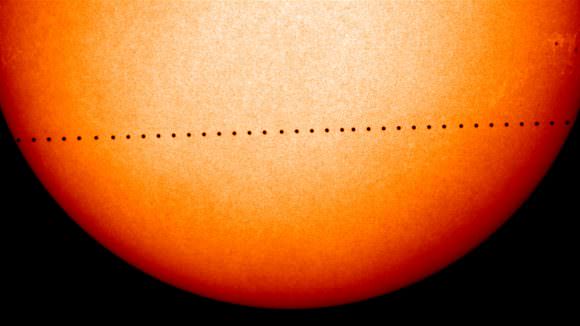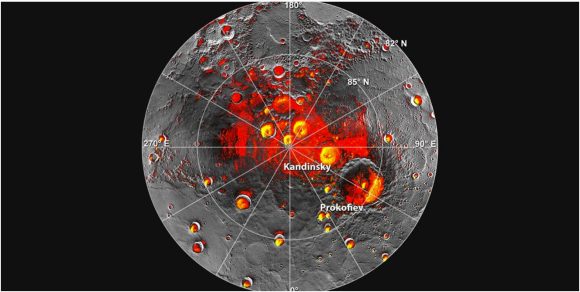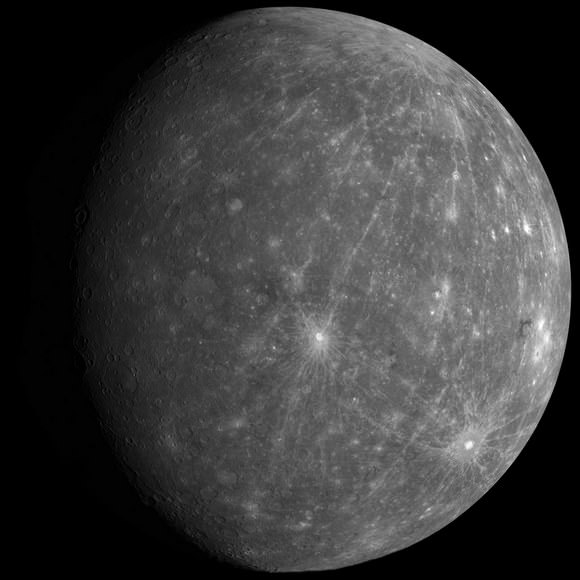Mercury is one of the most unusual planets in our Solar System, at least by the standards of us privileged Earthlings. Despite being the closest planet to our Sun, it is not the hottest (that honor goes to Venus). And because of its virtually non-existence atmosphere and slow rotation, temperatures on its surface range from being extremely hot to extremely cold.
Equally unusual is the diurnal cycle on Mercury – i.e. the cycle of day and night. A single year lasts only 88 days on Mercury, but thanks again to its slow rotation, a day lasts twice as long! That means that if you could stand on the surface of Mercury, it would take a staggering 176 Earth days for the Sun to rise, set and rise again to the same place in the sky just once!
Distance and Orbital Period:
Mercury is the closest planet to our Sun, but it also has the most eccentric orbit (0.2056) of any of the Solar Planets. This means that while its average distance (semi-major axis) from the Sun is 57,909,050 km (35,983,015 mi) or 0.387 AUs, this ranges considerably – from 46,001,200 km (2,8583,820 mi) at perihelion (closet) to 69,816,900 km (43,382,210 mi) at aphelion (farthest).

Because of this proximity, Mercury has a rapid orbital period, which varies depending on where it is in its orbit. Naturally, it moves fastest when it is at its closest to the Sun, and slowest when it is farthest. On average, its orbital velocity is 47.362 km/s (29.43 mi/s), which means it takes only 88 days to complete a single orbit of the Sun.
Astronomers used to suspect that Mercury was tidally locked to the Sun, meaning that it always showed the same face to the Sun – similar to how the Moon is tidally locked to the Earth. But radar-Doppler measurements obtained in 1965 demonstrated that Mercury is actually rotating very slowly compared to the Sun.
Sidereal vs. Solar Day:
Based on data obtained by these radar measurements, Mercury is now known to be in 3:2 orbital resonance with the Sun. This means that the planet completes three rotations on its axis for every two orbits it makes around the Sun. At it’s current rotational velocity – 3.026 m/s, or 10.892 km/h (6.77 mph) – it takes Mercury 58.646 days to complete a single rotation on its axis.
While this might lead some to conclude that a single day on Mercury is about 58 Earth days – thus making the length of a day and year correspond to the same 3:2 ratio – this would be inaccurate. Due to its rapid orbital velocity and slow sidereal rotation, a Solar Day on Mercury (the time it takes for the Sun to return to the same place in the sky) is actually 176 days.
In that respect, the ratio of days to years on Mercury is actually 1:2. The only places that are exempt to this day and night cycle are the polar regions. The cratered northern polar region, for example, exists in a state of perpetual shadow. Temperatures in these craters are also cool enough that significant concentrations of water ice can exist in stable form.
For over 20 years, scientists believed that radar-bright images from Mercury’s northern polar regions might indicate the presence of water ice there. In November of 2012, NASA’s MESSENGER probe examined the northern polar region using its neutron spectrometer and laser altimeter and confirmed the presence of both water ice and organic molecules.

Yes, as if Mercury weren’t strange enough, it turns out that a single day on Mercury lasts as long as two years! Just another oddity for a planet that likes to keep things really hot, really cold, and is really eccentric.
We’ve written many articles about Mercury for Universe Today. Here’s How Long is Day on the Other Planets?, Which Planet has the Longest Day?, How Long is a Day on Venus?, How Long is a Day on Earth?, How Long is a Day on the Moon?, How Long is a Day on Mars?, How Long is a Day on Jupiter?, How Long is a Day on Saturn?, How Long is a Day on Uranus?, How Long is a Day on Neptune?, and How Long is a Day on Pluto?
If you’d like more info on Mercury, check out NASA’s Solar System Exploration Guide, and here’s a link to NASA’s MESSENGER Misson Page.
We’ve also recorded an entire episode of Astronomy Cast all about Mercury. Listen here, Episode 49: Mercury.
Sources:

